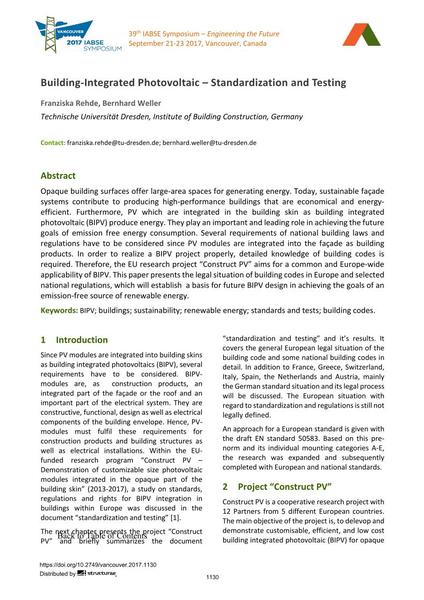Building-Integrated Photovoltaic – Standardization and Testing

|
|
|||||||||||
Bibliographic Details
| Author(s): |
Franziska Rehde
(Technische Universität Dresden, Institute of Building Construction, Germany)
Bernhard Weller (Technische Universität Dresden, Institute of Building Construction, Germany) |
||||
|---|---|---|---|---|---|
| Medium: | conference paper | ||||
| Language(s): | English | ||||
| Conference: | IABSE Symposium: Engineering the Future, Vancouver, Canada, 21-23 September 2017 | ||||
| Published in: | IABSE Symposium Vancouver 2017 | ||||
|
|||||
| Page(s): | 1130-1137 | ||||
| Total no. of pages: | 8 | ||||
| Year: | 2017 | ||||
| DOI: | 10.2749/vancouver.2017.1130 | ||||
| Abstract: |
Opaque building surfaces offer large-area spaces for generating energy. Today, sustainable façade systems contribute to producing high-performance buildings that are economical and energy- efficient. Furthermore, PV which are integrated in the building skin as building integrated photovoltaic (BIPV) produce energy. They play an important and leading role in achieving the future goals of emission free energy consumption. Several requirements of national building laws and regulations have to be considered since PV modules are integrated into the façade as building products. In order to realize a BIPV project properly, detailed knowledge of building codes is required. Therefore, the EU research project “Construct PV” aims for a common and Europe-wide applicability of BIPV. This paper presents the legal situation of building codes in Europe and selected national regulations, which will establish a basis for future BIPV design in achieving the goals of an emission-free source of renewable energy. |
||||
| Keywords: |
sustainability buildings BIPV renewable energy standards and tests building codes
|
||||
